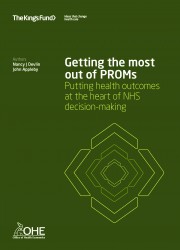Sign up to our newsletter Subscribe
Analysing Global Immunisation Expenditure

Sign up to our newsletter Subscribe


Getting the Most out of PROMS is a clearly written, comprehensive review of the practical issues involved in creating reliable PROMs, in presenting results both accurately and in usable formats, and applying them in making choices. More than 100 years…

Getting the Most out of PROMS is a clearly written, comprehensive review of the practical issues involved in creating reliable PROMs, in presenting results both accurately and in usable formats, and applying them in making choices.
More than 100 years ago Florence Nightingale suggested a health-related outcome measure for her patients: relieved, unrelieved and dead. Despite the developments in medical technology since then, attempts to measure the positive outcomes of health care have been slow in coming. An important step forward was made in 2009 when the English NHS began collecting patient-reported outcome measures (PROMs) for four elective procedures. Using a series of structured questions that ask patients about their health from their point of view, PROMs are intended to enable the patient perspective to inform decision-making at all levels of the NHS.
In early March 2010, the OHE and the King’s Fund jointly published Getting the Most out of PROMS: Putting Health Outcomes at the Heart of NHS Decision-Making (download) by Nancy Devlin and John Appleby. The publication is a clearly written, comprehensive review of the practical issues involved in creating reliable PROMs, in presenting results both accurately and in usable formats, and applying them in making choices. The review includes a primer on PROMs and a summary of insights from the Bupa experience with using PROMs, a program initiated in 1998.
The bulk of the publication looks at the tough questions raised by PROMs, including:
1. whether and how patients will use PROMs data to make choices
2. how best to report data publicly so that performance comparisons are both fair and clearly understood
3. the potentially pivotal role of PROMs in PCT commissioning decisions, recognizing both their promise and their limitations
4. clinicians’ acceptance of PROMs and the role of PROMs data in both referrals and clinical practice management
5. how to integrate PROMs into NHS assessments, combining them with traditional weighted activity measurements
The English PROMs programme currently focuses on four areas of elective surgery and can be extened to a much wider range of NHS services. The use of PROMs in other areas, such as services for patients with chronic conditions, offers potential advantages but poses a number of challenges. Yet perhaps the most critical factor in determining the value of PROMs to the NHS, the authors point out, is whether ‘decisions makers are prepared to act on the basis of these data’.
Download Devlin, N. and Appleby, J. (2010) Getting the most out of PROMs: Putting health outcomes at the heart of NHS decision-making. London: Kings Fund and Office of Health Economics.
An error has occurred, please try again later.
This website uses cookies so that we can provide you with the best user experience possible. Cookie information is stored in your browser and performs functions such as recognising you when you return to our website and helping our team to understand which sections of the website you find most interesting and useful.
Strictly Necessary Cookie should be enabled at all times so that we can save your preferences for cookie settings.
If you disable this cookie, we will not be able to save your preferences. This means that every time you visit this website you will need to enable or disable cookies again.
This website uses Google Analytics to collect anonymous information such as the number of visitors to the site, and the most popular pages.
Keeping this cookie enabled helps us to improve our website.
Please enable Strictly Necessary Cookies first so that we can save your preferences!



